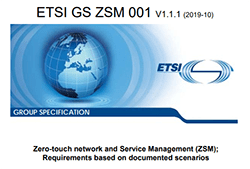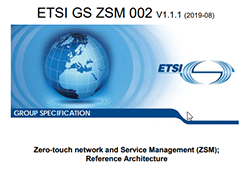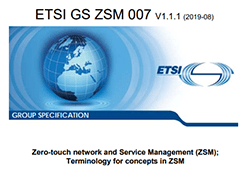Achievement of major milestone – publication of substantial ZSM specifications
ETSI ZSM group now prepares for the next term of activity.
The ETSI ZSM group was formed with the goal to accelerate the definition of the end-to-end service management architecture, spanning both legacy and virtualized network infrastructure, to enable automatic execution of operational processes and tasks. The pivotal deployment of 5G and network slicing has triggered the need for a radical change in the way networks and services are managed and orchestrated. Full end-to-end automation of network and service management has become an urgent necessity for delivering services with agility and speed and ensuring the economic sustainability of the very diverse set of services offered by Digital Service Providers. The ultimate automation target is to enable largely autonomous networks which will be driven by high-level policies and rules (AKA intent); these networks will be capable of self-configuration, self-monitoring, self-healing and self-optimization without further human intervention. All this requires a new horizontal and vertical end-to-end architecture framework designed for closed-loop automation and optimized for data-driven machine learning and artificial intelligence algorithms.
A major milestone was reached during the summer of 2019 with the publication of GS ZSM 001 (ZSM Requirements), GS ZSM 002 (ZSM Reference Architecture) and GS ZSM 007 (ZSM Terminology).
In GS ZSM 001, the ZSM group examined many business-oriented scenarios and the related automation challenges faced by operators and vertical industries. Subsequently, the team specified the architectural, functional and operational requirements for end-to-end network and service automation. The ZSM architectural framework specified in GS ZSM 002 was designed to satisfy these requirements. The resulting cutting-edge architecture is modular, flexible, scalable, extensible and service-based. The specified architecture supports open interfaces as well as model-driven service and resource abstraction. In my previous blog I have described how the ZSM management functions with their respective management service capabilities support rapid and efficient access to current, real-time management data as well as closed-loop automation. Work done in organizations such as 3GPP SA5, NFV, IETF, BBF, ONAP, OSM, TMF, etc. fits nicely into the ZSM architecture and can support the orchestration and automation of end-to-end services. The ZSM architecture provides a common foundation which allows a diverse ecosystem of open-source groups to produce interoperable solutions.
The ETSI ZSM group is currently working on the specification of solutions and management interfaces for the orchestration and automation of the emerging end-to-end network slicing technology as well as of the end-to-end, cross-domain service orchestration and automation. Recently, the group started work on specifying solutions to enable closed-loop automation. In addition, the group has agreed to study security aspects related to the ZSM framework and solutions and identify potential security threats and mitigation options that should be considered by the ZSM specifications to ensure that the automated processes are secured and deliver the intended business outcomes. Security is essential in the establishment of confidence in the automation process.
The ZSM technology addresses a clear market need and has a major global impact, helping to realize the ambitious vision of 5G. By the beginning of 2020 the ETSI ZSM group will have completed its initial two-year term as an ETSI Industry Specification Group (ISG). In September 2019 the ETSI Director General granted a two-year extension to the ETSI ZSM. The group intends to finalize and maintain the first term work. In addition, it will continue the technical work on the next level of details to provide interoperable solutions for enabling future operational processes and tasks to be executed automatically, end-to-end. Considered areas of work include: further details of the Integration Fabric, enablers for AI/ML applications in support of network and service automation, intent-based management, unified and expressive data formats to support AI/ML, cross-domain data services, support for new IT/Telco/Enterprise business models, the interface between the design time and the run time, management of ZSM, etc. The group will evaluate and consider the implications of emerging technologies (e.g. containers) on automation. New compelling use cases may identify additional missing parts that the ZSM group will agree to work on.
The ZSM group intends to maintain the overall mindshare and architectural integrity in ZSM (beyond ETSI) and strengthen the collaboration with related organizations to leverage synergies and achieve alignment. The group plans to work constructively with open source communities (e.g. ONAP) to ensure alignment that will allow integrating open-source software components in ZSM-based solutions.
We have just embarked on an exciting journey towards the automation transformation that will help operators meet user expectations for service agility and create new business opportunities. End-to-end automation is a “big deal” and represents the industry’s coming years journey. The use of AI/ML will evolve incrementally. Findings from real deployments and operational experience need to be fed into the specification work.
The ETSI ZSM group is open to both ETSI members and non-ETSI members. The different players in the value chain are welcome to join the ISG effort, contribute to the development of the specifications and demonstrate Proofs of Concepts (PoCs). Our next plenary week will be ZSM#09 at ETSI on 9-13 December.




